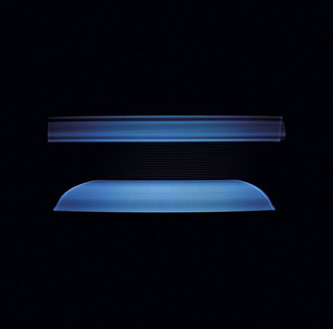 The
music of composer John Metcalfe is unique. In fact, it’s
so unique that it’s often hard to file it under known music categories.
One part avant garde, one part experimental, one part rock, one part
chill music, one part electronic… Anyway you get the drift. As
intriguing as John’s 2008 album, A Darker Sunset was,
things don’t get a lot more "indubitable" on his excellent
2015 album, The Appearance Of Colour. This time
around, there’s an even greater emphasis on pop-like sounds,
even though the album is mainly instrumental, with glimpses of wordless
female and male voices that sometimes drift out and in like alluring
soundscapes. There’s still a sonic comparison to the music of
U.K. trendsetters like William Orbit and Mike Oldfield, with slightly
less emphasis on guitar sounds, which are also played by Metcalfe.
Having recorded as a member of Durutti Column, Metcalfe also cites
Vini Reilly’s linear approach to electric guitar as being one
of his influences. Commenting on the making of The Appearance Of
Colour, Metcalfe explains, ‘Perhaps in the sense that
colour itself has no absolute meaning but can still provoke strong
reactions, my initial notion for the album was to try and write music
as free as possible from conscious narrative and create a sound world
that triggers more intense reaction in our nonverbal minds.’
In other words, keyboards, guitar sounds and various synth patterns
prevail alongside Metcalfe's lush string sounds. Fans of the minimalism
of composer Steve Reich, the sheer shock of The Art Of Noise, the
producer’s hat of William Orbit and others coming from that U.K.
school of sonic experimentation will enjoy Metcalfe’s dazzling
and disorienting soundscapes on The Appearance Of Colour. The Appearance
Of Colour is an amazing recording that takes its place among the
finest musical breakthroughs of 2015. www.John-Metcalfe.co.uk
The
music of composer John Metcalfe is unique. In fact, it’s
so unique that it’s often hard to file it under known music categories.
One part avant garde, one part experimental, one part rock, one part
chill music, one part electronic… Anyway you get the drift. As
intriguing as John’s 2008 album, A Darker Sunset was,
things don’t get a lot more "indubitable" on his excellent
2015 album, The Appearance Of Colour. This time
around, there’s an even greater emphasis on pop-like sounds,
even though the album is mainly instrumental, with glimpses of wordless
female and male voices that sometimes drift out and in like alluring
soundscapes. There’s still a sonic comparison to the music of
U.K. trendsetters like William Orbit and Mike Oldfield, with slightly
less emphasis on guitar sounds, which are also played by Metcalfe.
Having recorded as a member of Durutti Column, Metcalfe also cites
Vini Reilly’s linear approach to electric guitar as being one
of his influences. Commenting on the making of The Appearance Of
Colour, Metcalfe explains, ‘Perhaps in the sense that
colour itself has no absolute meaning but can still provoke strong
reactions, my initial notion for the album was to try and write music
as free as possible from conscious narrative and create a sound world
that triggers more intense reaction in our nonverbal minds.’
In other words, keyboards, guitar sounds and various synth patterns
prevail alongside Metcalfe's lush string sounds. Fans of the minimalism
of composer Steve Reich, the sheer shock of The Art Of Noise, the
producer’s hat of William Orbit and others coming from that U.K.
school of sonic experimentation will enjoy Metcalfe’s dazzling
and disorienting soundscapes on The Appearance Of Colour. The Appearance
Of Colour is an amazing recording that takes its place among the
finest musical breakthroughs of 2015. www.John-Metcalfe.co.uk
mwe3.com presents an interview
with
JOHN METCALFE
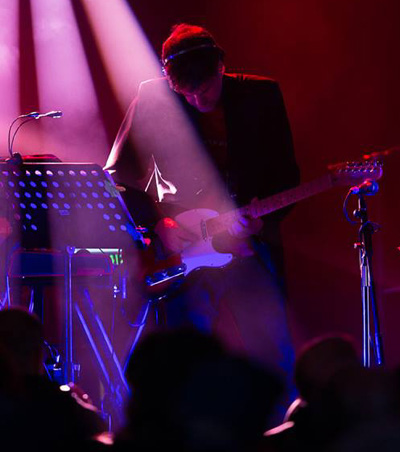 mwe3:
I consider The Appearance Of Colour to be the 21st century
equivalent of Close To The Edge – especially for the avant
gard minimalist post North Star era Philip Glass set. The
Appearance Of Colour incorporates so many different moods and
settings, including influences from late 1970s prog and minimalists
like Glass, Reich, Eno and others. With The Appearance Of Colour
was it your intention to create a new masterpiece of the genre?
mwe3:
I consider The Appearance Of Colour to be the 21st century
equivalent of Close To The Edge – especially for the avant
gard minimalist post North Star era Philip Glass set. The
Appearance Of Colour incorporates so many different moods and
settings, including influences from late 1970s prog and minimalists
like Glass, Reich, Eno and others. With The Appearance Of Colour
was it your intention to create a new masterpiece of the genre?
John Metcalfe: Thank you for calling it a masterpiece! I am
always drawn to music that has contrast within the confines of a piece
but also in an album overall. Certainly albums like Close To The
Edge have a quality that I love - that of a musical argument that
can span a good length of time - hopefully a whole record. It’s
always been my intention to use classical notions of time, structure
and proportion in my writing - whatever the “soundworld”.
mwe3: The album cover of The Appearance Of Colour is
sparse yet effective. Is there a meaning behind the title of the album
and the artwork concept? The cover art is bathed in blue light. Do
different colors have different effects on your music making approach?
John Metcalfe: Colors definitely affect my composing. I associate
keys with certain colours. C major is red, B minor is pale blue and
so on. The cover is a photo taken when an old cathode ray TV was turned
off. The title is a reference to the way that color without form or
perspective to define it can provoke strong reactions. In a similar
sense I wanted to create intense and contrasting music without any
particular theme or conscious narrative.
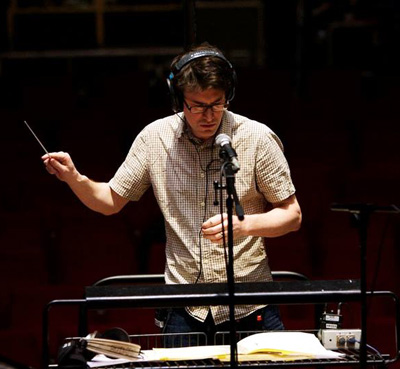 mwe3:
How did you become involved with Peter Gabriel and how many albums
and other releases have you done with Peter? When did you join Real
World as an artist, as I remember A Darker Sunset came out
on a label called The Big Chill.
mwe3:
How did you become involved with Peter Gabriel and how many albums
and other releases have you done with Peter? When did you join Real
World as an artist, as I remember A Darker Sunset came out
on a label called The Big Chill.
John Metcalfe: In 2008 I was involved in an amazing live composing
project with composer/ arranger Simon Hale, The Bays and the Heritage
Orchestra. Dickie Chappell, Peter’s engineer, came to a show
we did in Bristol in the UK. At the time Peter was looking for people
to collaborate with on a covers record (Scratch My Back) and
Dickie made the introduction. We spoke about music, life, different
composers, sandwiches and so forth. I came away with 4 tracks to demo
and played them to Peter in early 2009. I thought at most I’d
have the privilege of doing some strings on one song maybe but I never
imagined it would turn into 2 albums, co–producing and MD’ing
tours around the world. A thrill-ride for sure but one of the best
aspects, apart from working with the great man, was having use of
a full orchestra. With sample libraries abounding and money in the
music industry getting harder to find it was like being set free to
really explore how far we could push the idea of reinterpreting well-known
songs without being purely experimental for the sake of it. I guess
became a Real World artist when I released an album in 2013 of classical
chamber works for the Society of Sound series which they curate
for Bowers & Wilkins.
mwe3: I remember mwe3.com reviewing your 2008 album A
Darker Sunset and I sensed you had a very special sound. Can
you contrast A Darker Sunset with The Appearance Of Colour,
as far as your approach to writing and recording? I know you worked
with drummer Andy Gangadeen on both albums.
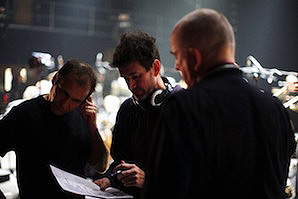 John
Metcalfe: With A Darker Sunset my approach, probably due
to the live-composing project, was to improvise, then edit and develop
material from there. A lot of the original improvisation sessions
ended up on the record. With The Appearance Of Colour, I worked
in a more classical way. I finished writing the material, printed
it up and only then recorded once I’d spent some time with it.
But I let the musicians involved in the record do their thing as much
as possible without directing them. There’s no point in getting
someone of Andy Gangadeen’s caliber and genius in only to over-shape
their musicianship
John
Metcalfe: With A Darker Sunset my approach, probably due
to the live-composing project, was to improvise, then edit and develop
material from there. A lot of the original improvisation sessions
ended up on the record. With The Appearance Of Colour, I worked
in a more classical way. I finished writing the material, printed
it up and only then recorded once I’d spent some time with it.
But I let the musicians involved in the record do their thing as much
as possible without directing them. There’s no point in getting
someone of Andy Gangadeen’s caliber and genius in only to over-shape
their musicianship
mwe3: Natasha Khan is the lone vocalist on The Appearance
Of Colour and she does a great job singing on track 3, “Just
Let Go”. What does Natasha bring to the track and what does the
track represent to you on the new CD?
John Metcalfe: I had been working with Natasha on her album
The Haunted Man and was working on The Appearance Of Colour
at the time so it was crazy not to ask her to be involved in some
way. She has such an incredible voice. I didn’t want to write
a song as such... I’ve always been interested in minimal lyrics
which are more open to interpretation. As I mentioned earlier, I’m
less interested in songs with a prescriptive narrative so I tend to
use the voice as an instrument rather than something with which to
predetermine the context of a song. So in answer to your question
it would be contrary of me to then say what the song represents.
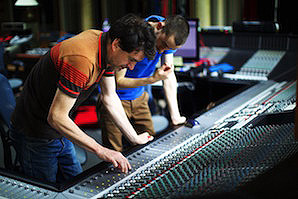 mwe3:
You play viola, keyboards and guitar. What instrument do you most
write most of your music on? It seems and sounds that you’re
foremost a composer and the instruments are there to provide colors
to the sound, not just to be the center of that sound.
mwe3:
You play viola, keyboards and guitar. What instrument do you most
write most of your music on? It seems and sounds that you’re
foremost a composer and the instruments are there to provide colors
to the sound, not just to be the center of that sound.
John Metcalfe: I think as I spent most of my time training
on the viola that’s usually my starting point. But I use the
guitar and keyboards a lot. Sound and timbre are crucial to my way
of working and quite often are the genesis for composing rather than
themes or motifs.
mwe3: What guitars are your favorite to play? Do you have special
keyboards, effects and favorite amps that you like to plug in to help
you get some unique sounds? Do you consider yourself a “gearhead”?
John Metcalfe: I only play a Fender Telecaster. I have a lovely
Gibson given to me by Chrissie Hynde but I never had it set up properly
and the Tele is so fab to play that I stick with that. I used to be
a gear head and had lots of boxes with twinkling lights but now I’ve
sold a lot of stuff and have as little hum in the room as possible.
I want gear to be transparent, to allow me to get what I am hearing
with as little process as possible. I’ve always loved delay and
I use it to create melody as well as for motor-rhythmic reasons. I
try lots of different materials for guitar picks - coins, cardboard,
nail files... whatever. My other sonic love is reverb, particularly
natural reverbs you hear in woods but that doesn’t always make
it onto the record.
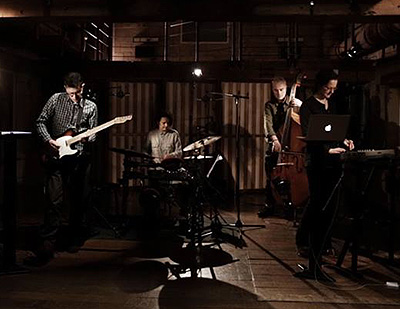 mwe3:
People don’t always remember that you were in the band Durutti
Column in the 1980s. They were kind of ahead of their time. Did you
record with Vini Reilly too? Do you consider Durutti Column to be
the first minimalist instrumental guitar-based band from the U.K.
and did you first become involved with Durutti Column when you worked
with Factory Records? And what were some of your favorite albums that
you worked on during the Factory years?
mwe3:
People don’t always remember that you were in the band Durutti
Column in the 1980s. They were kind of ahead of their time. Did you
record with Vini Reilly too? Do you consider Durutti Column to be
the first minimalist instrumental guitar-based band from the U.K.
and did you first become involved with Durutti Column when you worked
with Factory Records? And what were some of your favorite albums that
you worked on during the Factory years?
John Metcalfe: I joined Durutti in about 1984. Around that
time Vini was looking to do a neo-classical album, which yes, perhaps,
was ahead of its time in some aspects, predating the ‘post-classical’
movement of Max Richter, Johann Johannsen, Nils Frahm etc... Vini
was using a violinist from the U.S. called Blaine Rieninger but he
couldn’t do a tour so I replaced him. I remember the first rehearsal...
Vini wasn’t sure what to expect but I knew all the tunes so that
was that. We recorded lots of stuff together and toured all over.
I loved it. I was young at the time, so suddenly being in studios
and on tour was like being a kid in a sweet shop. Favourite albums
are The Guitar And Other Machines and the first set of classical
releases which I A&R’d.
mwe3: I hear a little Mike Oldfield and Philip Glass in your
sound. That sound really took off in the late 1970s. How important
were those artists in your guitar and string ideas and composing?
John Metcalfe: Well I like Mike Oldfield’s music a lot
but I wasn’t a real fan as such so I couldn’t say his music
was a factor in my background, nor in fact Philip Glass! Steve Reich,
however, was a huge influence and I have played his music in my string
quartet, the Duke, on many occasions. And of course Durutti is a massive
part of my musical life and my sound has definitely been shaped by
my time with Vini.
 mwe3:
What pop, rock and classical artists made the biggest impression on
you while growing up? You grew up in New Zealand so when did you move
to England? How would you contrast life in New Zealand with living
in the U.K.? What are your ties to New Zealand these days and were
you influenced by music from New Zealand? Split Enz comes to mind.
mwe3:
What pop, rock and classical artists made the biggest impression on
you while growing up? You grew up in New Zealand so when did you move
to England? How would you contrast life in New Zealand with living
in the U.K.? What are your ties to New Zealand these days and were
you influenced by music from New Zealand? Split Enz comes to mind.
John Metcalfe: I left New Zealand when I was 8. I remember
liking a record called "Daddy Cool" but I don’t think
it left any lasting impressions. Kraftwerk had a big impact on me
as did Bach but there was lots of other music... punk... one band
in particular called Discharge and new wave and then house music which
I spent a lot of time dancing to in the Hacienda in Manchester.
I loved string music for obvious reasons but was also fascinated by
production... how instruments worked and how the process of recording
and effects modulated their sound. I was in a band at school and we
used to take the lid off of equipment and poke around to get it to
make noises it wasn’t meant to make. I still have family in New
Zealand and visit when I can. I think I will always have a yearning
to return there full time even if it’s just for the weather.
Living in the UK... always I find I want stronger colours, more contrast,
more intensity in the sky and sea which New Zealand has in plenty.
mwe3: Do you consider some rock music, especially the albums
made in the early 1970s, from the U.K. to be the classical music of
coming decades? Can you see a time when certain music written by artists
such as YES or Genesis will be played the way classical music is often
played today? Also, have you heard the music of Pekka Pohjola?
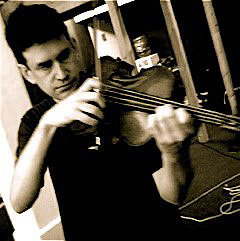 John
Metcalfe: I think those classic prog rock years produced music
that could easily be seen as classical... in terms of the length and
structure of the songs. The idea of themes being developed and returning
in different ways in different keys and settings... all very classical.
So, of course it can all be performed live with orchestras and so
forth. I think bands like YES have certainly done that. Though, overall
I hope that people are decreasingly bothered about where one style
ends and another begins and the discussion about this genre or that
hopefully has less and less meaning. Many electronic musicians for
quite a while now have loved using acoustic instruments, found sounds
and so forth and vice versa with classical, jazz or world. It’s
all sound, it’s all waveforms, who cares whether it can or can’t
be used in one genre or another. As long as the music has emotion,
intellect and spirit it doesn’t matter what you use to achieve
that. No, I haven’t heard Pohjola’s music but I will certainly
check it out!
John
Metcalfe: I think those classic prog rock years produced music
that could easily be seen as classical... in terms of the length and
structure of the songs. The idea of themes being developed and returning
in different ways in different keys and settings... all very classical.
So, of course it can all be performed live with orchestras and so
forth. I think bands like YES have certainly done that. Though, overall
I hope that people are decreasingly bothered about where one style
ends and another begins and the discussion about this genre or that
hopefully has less and less meaning. Many electronic musicians for
quite a while now have loved using acoustic instruments, found sounds
and so forth and vice versa with classical, jazz or world. It’s
all sound, it’s all waveforms, who cares whether it can or can’t
be used in one genre or another. As long as the music has emotion,
intellect and spirit it doesn’t matter what you use to achieve
that. No, I haven’t heard Pohjola’s music but I will certainly
check it out!
mwe3: Do you consider yourself a classical musician first and
foremost or a rock musician? How do you find The Appearance Of
Colour is being received by the classical music audience and the
press / critics as well? Is there still a bias against bringing rock
elements into the classical realm? Is bringing the two genres closer
together something you changed in your music for the better?
John Metcalfe: I’m certainly happy that my classical training
has allowed me to work with some incredible musicians in those areas
and then bring that to the electronic side. Yes, there is bias and
bigotry. One mentality I encounter is that when orchestral instruments
are used in pop/rock music it is deemed pompous or bombastic. A lot
of people get very excited about simplicity... the schools of ‘you
shouldn’t have/need more than 4 elements in a song’ and
‘you don’t achieve power through complexity’. I’m
not sure Stravinsky was thinking that when he wrote "The Rite
Of Spring" or when Beethoven wrote the “Grosse Fugue”.
Of course there’s narrow-mindedness from the classical side too.
People who would never listen to anything with drums or electric guitar
for example. Complex music or simple music, if it’s written and
performed well, is extraordinary. If you only listen to one or two
styles of music you lose out. In a workshop the other day, I suggested
the participants listen for a month only to the 3 types of music they
think they dislike the most and then to write something in that style
for instruments they feel most antipathy to. That process is interesting...
to challenge our own opinions ourselves and to maybe discover exactly
why we don’t like something.
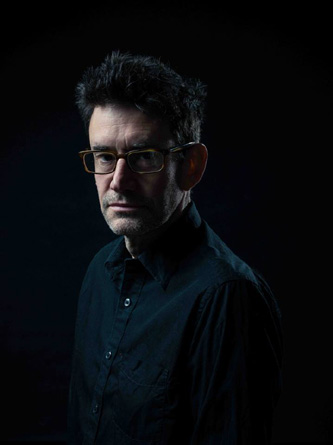 mwe3:
How do you feel the internet has changed your approach to music making
and even music marketing? It’s so amazing to feel part of such
a big whole, the Earth, via the web, but at the same time, knowing
that you’re still stuck in your little town. Is the internet
a huge dream machine and where do you see the internet in 2050?
mwe3:
How do you feel the internet has changed your approach to music making
and even music marketing? It’s so amazing to feel part of such
a big whole, the Earth, via the web, but at the same time, knowing
that you’re still stuck in your little town. Is the internet
a huge dream machine and where do you see the internet in 2050?
John Metcalfe: Like many people I have a love/hate relationship
with the internet. Because of technology I now spend many hours each
day staring at screens and I’m not convinced it’s the best
way to make music. I try to force myself to close my eyes when listening
as the graphics and colours affect my responses for sure. Like most
things, the internet has its good and bad points. Sure I can send
files quicker and work remotely but I prefer to work with other humans
in the same room. You can’t rehearse remotely. Maybe that will
be possible in 2050...
mwe3: What do you like to do to relax in your down time or
is it always music 24/7 with you? I know you wrote some great music
for the Arctic Ice cause so I imagine you’re very active in various
environmental causes. Is there hope for mankind? Where do you see
Earth in 2099 after 100 years of broad band?
John Metcalfe: I don’t really relax but I should do! It’s
24/7 really... Much as I’d like to be, I’m not an optimist
for humankind. I think we are evolving ourselves into extinction,
so ultimately the planet will be saved anyway. It’s just that
we won’t be there to see it. But in the meantime we have to try!
So climate change should be the only game in town. Yes, we have to
tackle inequality, the huge gap between rich and poor, the promotion
of the individual over the community, poverty, health, education and
wars but without a fundamental change of worldwide political will
to really take the issue on and without a deep-rooted shift in our
desires as consumers, we will not take the steps necessary to stop
temperatures rising, leading to weather systems changing permanently.
2099? Faster broadband speeds won’t have stopped the ice-caps
melting. If anything the ever-increasing sizes of the huge servers
necessary will simply speed up the process.
mwe3: Aren't you also involved in some of the other new music
makers on Real World such as Tom Kerstens? What can you tell us about
Tom and your involvement with him? What other Real World artists interest
you? Does Peter Gabriel do most of the A&R on Real World?
John Metcalfe: I have known Tom for many years now and have
composed quite a few short pieces for him and his G+ ensemble featuring
2 guitars, string quartet and vibraphone. I also produced an album
for The Creole Choir Of Cuba who were extraordinary although I hardly
did anything really, just made sure they were fed, happy and mic’d
up properly. Apart from that they just did their own amazing thing.
Yes Peter listens to everything that is proposed for the label but
is not involved in the initial A+R process as such.
 mwe3:
What can you tell us about your work with Duke Quartet? How many albums
have you made with Duke Quartet and how would you compare those albums
with your solo works?
mwe3:
What can you tell us about your work with Duke Quartet? How many albums
have you made with Duke Quartet and how would you compare those albums
with your solo works?
John Metcalfe: I’ve been with the quartet for about 20
years. We’ve made several albums with repertoire ranging from
Dvorak to contemporary and plenty of others collaborating with some
amazing artists. We’ve toured all over the world and been privileged
to play exquisite music in beautiful venues. I wouldn’t really
want to compare the recordings to my solo work though. The process
of rehearsing and recording existing repertoire is different to creating
an album of your own compositions. I really enjoy the collaborative
aspect of working with other musicians. While we don’t always
agree it’s crucial to keeping the ideas and processes in a state
of flux so you don’t get stuck in particular habits.
mwe3: Even though, The Appearance Of Colour recently
came out are you planning any other projects in 2016 as far as writing,
recording, producing and/or releasing other projects in the coming
year?
John Metcalfe: I have another album coming out on ECC records
which is a collaboration with writer/producer Simon ‘Palmskin’
Richmond. It’s called Set In Stone. I’m also involved
in a very exciting project in Italy which I’m not allowed to
tell anyone about yet. I’m also working on new material with
an amazing British singer called Rosie Doonan who’s been working
with Birdy recently…



